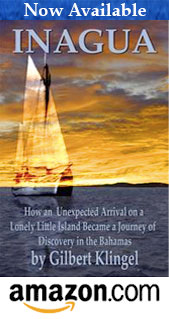 BOOKS OF THE TIMES
BOOKS OF THE TIMES
By Ralph Thompson
New York Times
October 15, 1940
If you have ever gone by steamer from New York to Port au Prince, Kingston or Santiago de Cuba, you will remember passing, on the third or fourth day out, the white beaches and low green hills of the Bahama Islands-one after an~ other for a matter of twenty-four hours, more or less, depending on the speed of your ship and how its course happened to lie. If you are a city-bred romantic, you probably leaned on the rail and wondered what these islands’ were like and why no one seemed to be living on them.
A good many people do live on them-on a certain few of the group, that is, notably at Nassau, on New Providence Island, over toward civilization, the Duke of Windsor and the Florida shore. But there are 600 or 700 Bahamas all told, scattered over an area nearly 1,000 miles long, and of these only twenty or so are inhabited. The rest, ranging upward in size from tiny keys to places large enough to show on a household atlas map, are about as they were when Columbus landed at San Salvador in 1492.
Some years ago a young Baltimore naturalist named Gilbert Klingel spent about six months exploring Inagua, one of the largest and remotest of the islands, and later returned for another visit. His report, now published, * gives a good idea of why most of the Bahamas are not inhabited (Inagua itself is, to some extent) and is likewise, and mainly, excellent natural history, although here and there the writing is on the florid and fancy side.
Mr. Klingel arrived on his island by mistake. Back in the Winter of 1929-30 lle and a friend bought a yawl and started out on a West Indian collecting trip for the American Museum of Natural History. One night their yawl was wrecked on a reef, and they swam ashore with such apparatus and supplies as could be salvaged. When the sun came up they saw a waste of sand, cactus, mangrove and thatch palm, with crabs crawling everywhere and thousands of birds flying around.
This was Inagua, although they didn’t realize it for some time, since the first humans they met were a couple of small Negro boys who rolled their eyes and almost collapsed from fright when spoken to. But eventually they made their way to Mathewtown, the only “city” on the island, and here, after considerable wrangling with the authorities, were given permission to stay. The friend soon took a passing freighter back to Baltimore, and Mr. Klingel set up housekeeping in a. shack beyond the city limits-for Mathewtown turned out to be (apparently it has since improved) a sad aggregation of old houses, mangy dogs and interbred blacks, mulattos and octoroons.
As for the island itself, it was hardly romantic. The only fauna of any size were wild hogs, donkeys and cows, all of which grunted and brayed and devoured the garden truck raised by lonely. and half-dead Negro farmers. The only drinking water was brackish rain water. The weather was painfully hot during the day, and after dark the air was thick with bats, mosquitos and sandflies. The vegetation was either desertlike or the rank, matted growth of a swampy, semi-tropical jungle.
For a naturalist, however, it was paradise, with lagoons swarming with fish, crustaceans and gastropods, and flamingos, egrets, hummingbirds, lizards and spiders on every hand. Mr. Klingel wandered about as he pleased and as long as his films and provisions held out, returning later with more films and provisions and better equipment. His descriptions bf the local ecology are particularly good, likewise his chapters called “Inagua. Is a Queer Little Island,” “In Defense of Octopuses” and “The Edge of the Edge of the World.”
*INAGUA. By Gilbert C. Klingel. 386 pages. Dodd Mead. $3.


